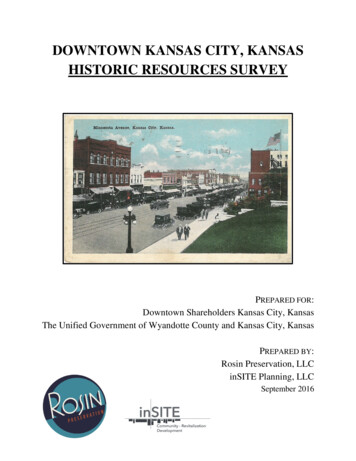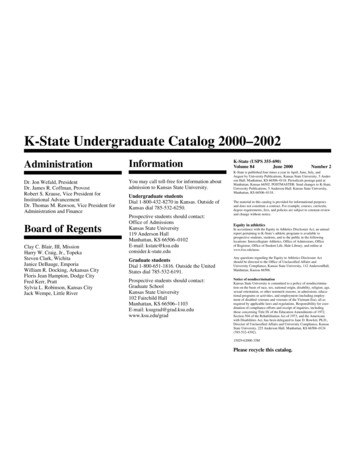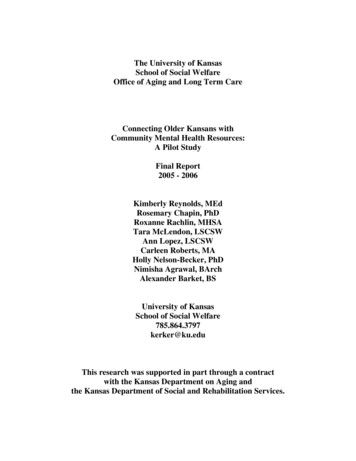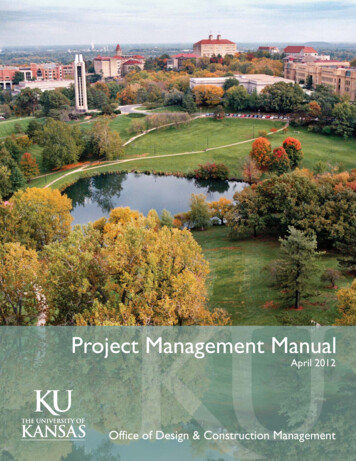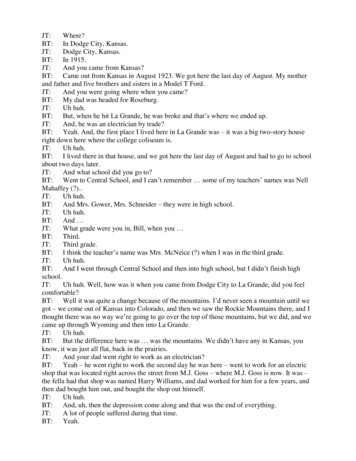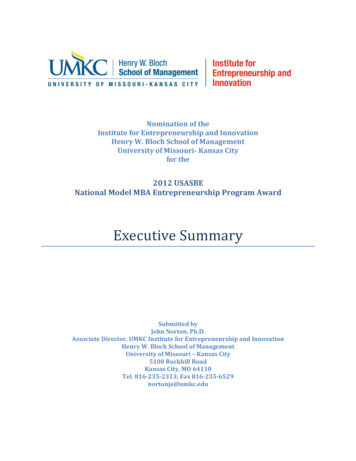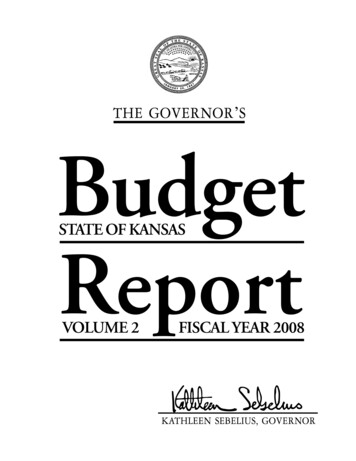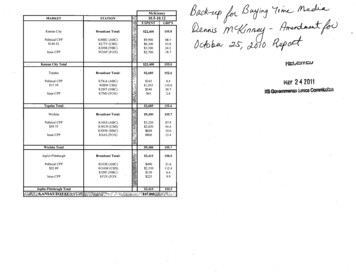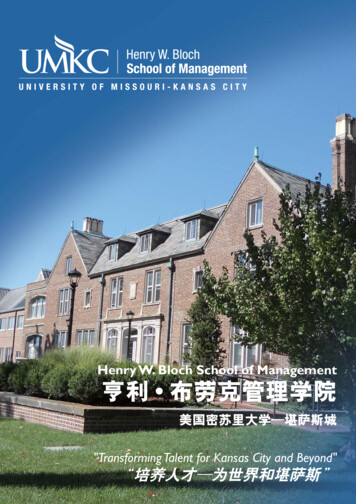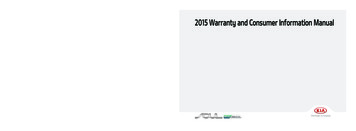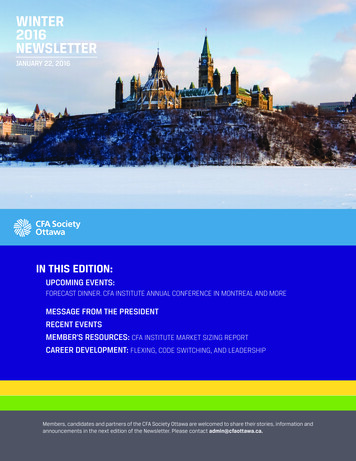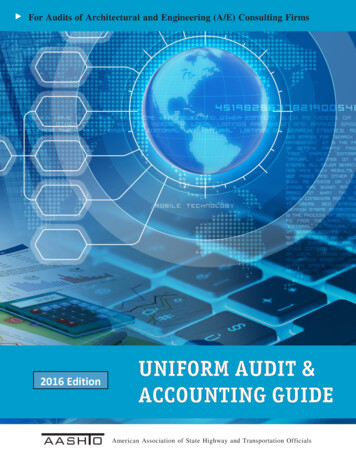
Transcription
For Audits of Architectural and Engineering (A/E) Consulting Firms2016 EditionAmerican Association of State Highway and Transportation Officials
NSERT NEW INSIDE COVER PAGE2016 EDITIONCopyright 2016, by the American Association of State Highway and Transportation Officials. All Rights Reserved.This book, or parts thereof, may not be reproduced in any form without written permission of the publisher.Printed in the United States of America.
ACKNOWLEDGMENTSDiscussions among AASHTO members at the regional level and at annual AASHTO meetings led to thecreation of the first edition of the Uniform Audit & Accounting Guide, as released in March of 2001. TheGuide was designed to assist engineering consultants, independent CPAs, and State DOT auditors with thepreparation, and/or auditing, of Statements of Direct Labor, Fringe Benefits, and General Overhead(indirect cost rate schedules).Over the years, many people have contributed to the Guide by providing input, conducting research,attending working sessions, facilitating meetings, editing, proofreading, and providing other support. Theparticipants included representatives from State Departments of Transportation, the FHWA, the AmericanCouncil of Engineering Companies (ACEC), public accounting firms, and AASHTO. Their knowledge,time, travel funding, and supplies were instrumental in the nationwide team effort that led to this 2016edition of the Guide.Scot P. Gormley, External Audit Manager with the Ohio Department of Transportation, served as theprimary designer and editor of this 2016 Edition of the Guide, with additional support and assistanceprovided by Dan Purvine of A/E Clarity Consulting and Training, LLC.AASHTO Uniform Audit & Accounting Guide (2016 Edition)
AASHTO Uniform Audit & Accounting Guide (2016 Edition)
PrefaceABOUT THIS GUIDEThis Uniform Audit and Accounting Guide was developed by the American Association of StateHighway and Transportation Officials (AASHTO) Audit Subcommittee with assistance from theAmerican Association of State Highway and Transportation Officials, the Federal HighwayAdministration (FHWA), and the American Council of Engineering Companies (ACEC). TheAASHTO Audit Subcommittee is comprised of the senior audit representative from each State’stransportation or highway department. This Guide was developed over several years and initially wasapproved by AASHTO at the organization’s 2001 annual meeting.During 2007, the members of the Audit Subcommittee approved the establishment of a Task Force toupdate the Guide. The work of the Task Force resulted in a major update of the Guide in 2010 (the 2010Edition), which was further refined and updated in 2012 (the 2012 Edition). These revisions werenecessary to ensure that the Guide was consistent with current auditing standards and procedures,accounting principles, and Federal regulations. The 2010 and 2012 revisions also addressed questions andconcerns expressed by various parties, including the FHWA, State DOT audit agencies, Architectural andEngineering design firms (hereinafter referred to as “A/E firms” or “engineering consultants”), and publicaccounting firms. These questions and concerns arose through current practice and, in part, through thefindings and recommendations from an audit performed by the U.S. Department of Transportation’sOffice of Inspector General (OIG).1This 2016 Edition of the Guide incorporates several updates, refinements, and clarifications necessary toreflect changes in the statutory and regulatory framework applicable to A/E contracts that have occurredsince the publication of the 2012 Edition. This 2016 Guide should be used as a tool by State DOTauditors, A/E firms, and public accounting firms that perform audits and attestations of A/E firms. Thetechniques presented herein primarily focus on examination, auditing, and reporting procedures to beapplied to costs that are incurred by A/E firms for engineering and design-related services performed onvarious Federal, State, and Local transportation projects.The techniques discussed in this Guide were designed to be applied to audit and attestation engagementsperformed in connection with engineering consultants’ Statements of Direct Labor, Fringe Benefits, andGeneral Overhead (hereinafter referred to as “indirect cost rate schedules”), as well as the relatedaccounting systems, job-costing systems, and labor-charging systems that serve as the basis for theindirect cost rate schedules. However, this Guide is not intended to be a comprehensive auditingprocedures manual but is instead a guide to assist users in understanding terminology, policies, proceduresand audit techniques, and sources for applicable Federal Regulations. This Guide provides only generalguidance and is not meant to, and cannot, supersede either the Federal Acquisition Regulation (FAR) orany related laws or regulations.2Users should be aware that the FAR Cost Principles change frequently; accordingly, please review theSee “Oversight of Design and Engineering Firms’ Indirect Costs Claimed on Federal-Aid Grants” (Report Number:ZA-2009-033), issued February 5, 2009.12Although use of this Guide is not required by Federal law or regulation, most State DOTs expect engineeringconsultants, external CPAs, and other involved parties to comply with the minimum procedures and techniquesillustrated and discussed herein. As recommended by the FHWA, most State DOTs have adopted risk assessmentprocedures to help determine engineering consultants’ compliance with FAR Part 31 and related laws andregulations. Consistency with this Guide may be a key factor in assessing risk, and departures from the proceduresrecommended herein, lacking adequate justification, may lead to additional scrutiny by a reviewing State DOT.Accordingly, engineering consultants are strongly encouraged to adopt the uniform reporting procedures illustratedherein, including, but not limited to, labor charging practices, cost accumulation and reporting processes, and theformat and content of indirect cost schedules (including the recommended standard disclosures). Engineeringconsultants should contact their respective cognizant State DOTs for further details and clarifications regarding riskassessment and application of this Guide.AASHTO Uniform Audit & Accounting Guide (2016 Edition)
applicable FAR version in conjunction with this Guide. Likewise, illustrations and sample reports eitherincluded or referenced herein were derived from various sources and information current at the time theGuide was published. Due to periodic changes in Generally Accepted Accounting Principles (GAAP),Generally Accepted Auditing Standards (GAAS), and Government Auditing Standards (GAGAS or the“Yellow Book”), users should refer to any applicable, more current guidance/standards and modify thesample reports accordingly.Note: Please see the AASHTO website for contact information for all State transportation agencies.An electronic version of this Guide is available on the AASHTO home page: www.transportation.org.AASHTO Uniform Audit & Accounting Guide (2016 Edition)
CONTENTSCHAPTER 1 – ORGANIZATION OF THIS GUIDE AND DEFINED TERMS .11.1 – ORGANIZATION OF THIS GUIDE .11.2 – GENERAL TERMS . 11.3 – OTHER DEFINED TERMS .3CHAPTER 2 – ADEQUACY OF ACCOUNTING RECORDS . 112.1 – INDIRECT COST RATE SCHEDULE .11A. Generally .11B. Facilities Capital Cost of Money and Other Items .12C. Disclosure of Field Office Rates . 12D. Accounting Period: Application of Submitted Indirect Cost Rates .122.2 – UNALLOWABLE COSTS . 13A. Generally .13B. Directly-Associated Costs.132.3 – FINANCIAL STATEMENTS.132.4 – MANAGEMENT REPRESENTATIONS . 142.5 – MANAGEMENT AND CPA’S ROLES AND RESPONSIBILITIES . 14A. Management Responsibilities .14B. The CPA Auditor’s Responsibilities . 151. Generally . 152. The CPA’s Responsibilities for Fraud Detection . 15C. Selection of CPA Firm as Overhead Auditor .16CHAPTER 3 – STANDARDS FOR ATTESTATIONS AND AUDITS . 193.1 – BACKGROUND. 193.2 – ENGAGEMENT TYPES . 19A. Review of Indirect Cost Rates for Costs Incurred .19B. Indirect Cost Rate (Forward Pricing) Review.19C. Contract Pre-Award Review .20D. Contract Cost Review .203.3 – AUDITING STANDARDS. 20A. Government Auditing Standards (“Yellow Book” or “GAGAS” Standards) . 20B. GAGAS Engagement Types .211. Financial Audits .212. Attestation Engagements .213. Performance Audits .213.4 – OPINION ON INTERNAL CONTROL.21CHAPTER 4 – COST PRINCIPLES .234.1 – OVERVIEW OF FEDERAL ACQUISITION REGULATION, PART 31 . 234.2 – STATE AND LOCAL COST PRINCIPLES . 234.3 – ALLOWABILITY, INCLUDING REASONABLENESS .24A. Generally .24B. Requirements of FAR 31.201-2 and FAR 31.201-3 . 25C. Methodologies for Applying FAR 31.201-3 .251. Using Quantitative Analysis to Determine Ordinary Cost .252. Determining Reasonableness: Common Cost Categories . 264.4 – ALLOCABILITY . 264.5 – UNALLOWABLE COSTS . 264.6 – DIRECT AND INDIRECT COSTS .264.7 – APPLICABILITY OF COST ACCOUNTING STANDARDS .274.8 – ALLOCATION BASES FOR INDIRECT COSTS . 27AASHTO Uniform Audit & Accounting Guide (2016 Edition)
CONTENTSCHAPTER 5 – COST ACCOUNTING .295.1 – ALLOCATION BASES, GENERALLY .29A. Direct Labor Cost . 29B. Direct Labor Hours .29C. Total Labor Hours (Total Hours Worked) .29D. Total Cost Input . 29E. Total Cost Value Added .29F. Consumption/Usage .295.2 – ACCOUNTING FOR UNALLOWABLE COSTS IN ALLOCATION BASES .305.3 – COST CENTERS . 30A. Functional Cost Centers.31B. Subsidiaries, Affiliates, Divisions, and Geographic Locations .315.4 – ALLOCATED COSTS . 31A. Generally .31B. Fringe Benefits . 31C. Overhead.31D. General and Administrative (G&A) . 31E. Internally-Allocated Costs (Company-Owned Assets). 321. Computer/CADD Costs .322. Fleet or Company Vehicles.323. Equipment. 324. Printing/Copying/Plan Reproduction .32F. Internal Labor Costs .321. Direct Labor . 322. Uncompensated Overtime for Salaried Employees . 333. Overtime Premium.354. Other Considerations Regarding Internal Labor Costs . 365. Potential Areas of Risk Regarding Internal Labor . 376. Sole Proprietors’ and Partners’ Salaries .37G. Contract Labor/ Purchased Labor . 375.5 – OTHER DIRECT COSTS-OUTSIDE VENDORS/EMPLOYEE EXPENSE REPORTS .385.6 – FIELD OFFICE RATES . 38A. Generally .38B. Types of Field Offices .39C. Cost Accounting Considerations. 391. Field Office Direct Labor .392. Field Office Indirect Costs.393. Other Considerations Regarding Indirect Cost Allocations .40CHAPTER 6 – LABOR-CHARGING SYSTEMS AND OTHER CONSIDERATIONS . 456.1 – BACKGROUND. 456.2 – LABOR COSTS, GENERALLY .456.3 – LABOR COSTS ASSOCIATED WITH BID AND PROPOSAL AND SELLING ACTIVITIES . 46A. Bid and Proposal Costs (B&P) . 461. B&P Definition . 462. B&P Identification and Accumulation .463. B&P Efforts Sponsored by Grant or Required by Contract .46B. Selling Effort and Activities .461. Direct Selling . 462. Brokerage Fees, Commissions, and Similar Costs . 473. Other Cost Principles Related to Selling Efforts . 474. Recordkeeping Requirements . 47AASHTO Uniform Audit & Accounting Guide (2016 Edition)
CONTENTS6.4 – DCAA ACCOUNTING GUIDE .48A. Accounting System Internal Control. 48B. Labor Charging System Internal Control .481. Generally . 482. Timecard Preparation .493. Timekeeping Policy .506.5 – COMPLIANCE AND REVIEW .50CHAPTER 7 – COMPENSATION .537.1 – GENERAL PRINCIPLES . 537.2 – ALLOWABILITY OF COMPENSATION. 537.3 – REASONABLENESS OF COMPENSATION. 547.4 – STATUTORY COMPENSATION LIMIT: THE BENCHMARK COMPENSATION AMOUNT (BCA) .557.5 – DETERMINING THE REASONABLENESS OF EXECUTIVE COMPENSATION .56A. Generally .56B. Procedures for Determining Reasonableness .56C. Performing a Compensation Analysis in Compliance with FAR 31.205-6, Techplan, andInformation Systems . 567.6 – CRITERIA FOR DEMONSTRATING SUPERIOR PERFORMANCE . 59A. Generally .59B. Procedure for Establishing Compensation Amounts in Excess of Survey Medians.597.7 – STATE DOT OVERSIGHT: REVIEW OF EXECUTIVE COMPENSATION.61A. Reviewing the Engineering Consultant’s Compensation Analysis .61B. Using the National Compensation Matrix (NCM) to Evaluate Executive Compensation .617.8 – EXECUTIVE COMPENSATION—REQUIRED SUPPORTING DOCUMENTATION .627.9 – ADDITIONAL PROCEDURES – RELATED PARTIES .627.10 – SPECIAL CONSIDERATION FOR CLOSELY-HELD FIRMS .637.11 – BONUS AND INCENTIVE PAY PLANS . 64A. Bonus and Incentive Plans .64B. Profit-Distribution Plans .64C. Documentation of Bonus and Profit-Distribution Plans. 647.12 – FRINGE BENEFITS . 65A. Deferred Compensation, Generally . 65B. Pension Plans . 65C. Employee Stock Ownership Plans (ESOPs) .66D. Severance Pay. 677.13 – SUPPLEMENTAL BENEFITS.67A. Supplemental Executive Retirement Plans (SERPs). 67B. Long-Term Incentive (LTI) Plans . 68C. Executive Severance .68D. Golden Parachutes . 68E. Golden Handcuffs . 68CHAPTER 8 – SELECTED AREAS OF COST . 698.1 – BACKGROUND. 69A. Directly-Associated Costs .69B. Burden of Proof . 70C. Determining Reasonableness .70D. Direct Costs . 708.2 – ADVERTISING AND PUBLIC RELATIONS . 70A. Advertising Costs . 70B. Trade Show Expenses and Labor. 71C. Public Relations Costs .71D. Bad Debts and Collection Costs . 718.3 – COMPENSATION . 718.4 – PERSONAL USE OF COMPANY VEHICLES . 71AASHTO Uniform Audit & Accounting Guide (2016 Edition)
CONTENTS8.5 – CONTRIBUTIONS OR DONATIONS .728.6 – FACILITIES CAPITAL COST OF MONEY (FCCM) .728.7 – DEPRECIATION . 72A. Depreciation Expense Presented Is Same for Both Financial and Income Tax Purposes .73B. Depreciation Expense Presented For Financial Purposes Differs From Income Tax Purposes. 738.8 – EMPLOYEE MORALE, HEALTH, AND WELFARE .738.9 – ENTERTAINMENT . 748.10 – FINES AND PENALTIES .748.11 – GAINS AND LOSSES ON DEPRECIABLE PROPERTY .748.12 – IDLE FACILITIES AND IDLE CAPACITY COSTS .758.13 – BID AND PROPOSAL COSTS .758.14 – PRECONTRACT COSTS .758.15 – INSURANCE .76A. Insurance on Lives of Key Personnel . 76B. Professional Liability Insurance . 76C. Losses and Insurance Deductibles . 76D. Self Insurance . 768.16 – INTEREST COSTS . 778.17 – LOBBYING COSTS. 778.18 – LOSSES ON OTHER CONTRACTS .778.19 – ORGANIZATION AND REORGANIZATION COSTS .
AASHTO Uniform Audit & Accounting Guide (2016 Edition) ACKNOWLEDGMENTS Discussions among AASHTO members at the regional level and at annual AASHTO meetings led to the creation of the first edition of the Uniform Audit & Acc
